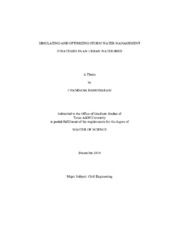| dc.description.abstract | Land development transforms the natural landscape and impacts in stream ecosystems and downstream communities as it alters the natural flow regime. An increase in impervious areas results in higher volumes of storm water runoff, reduced time to peak, and more frequent flooding. Best Management Practices (BMP) and Low Impact development (LID) are a few of the set of measures which are used to mitigate the impact of urbanization. Peak flow, runoff volume are few of the conventional metrics which are used to evaluate the impact and performance of these storm water management strategies on the watershed. BMP are majorly used to control the flood runoff but results in the release of large volumes of runoff even after the flood wave passed the reach and LIDs are used to replicate the natural flow regime by controlling the runoff at the source. Therefore need to incorporate a metric which includes the timing and area being inundated needs to be considered to study the impact of these strategies on the downstream.
My proposed research will focus on simulating the Low Impact Development (LID) techniques like permeable pavements and rainwater harvesting on an urbanized watershed using a curve number approach to quantify the hydrologic performance of these strategies on the watershed. LID, BMPs, and combined strategies are introduced for retrofitting existing conditions and their hydrologic performance is accessed based on the peak flow and a new metric Hydrologic Footprint Residence. A simulation optimization framework would be developed which identifies cost effective LID options that maximize the reduction of peak flow from the existing condition design storms while meeting budget restrictions. Further LID and BMP placement is included in the optimization model to study the impact of the combined scenario on the storm water management plans and their performance based on different storms and corresponding budget. Therefore a tradeoff can be illustrated between the implementation cost and the hydrological impact on the watershed based on the storm water management approach of using only LID and combination of LID and BMP corresponding to varied spectrum of design storm events. | en |


